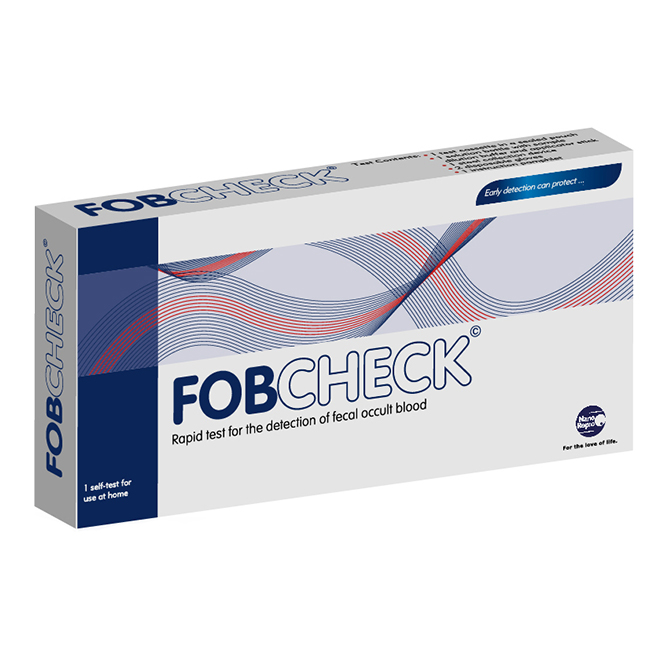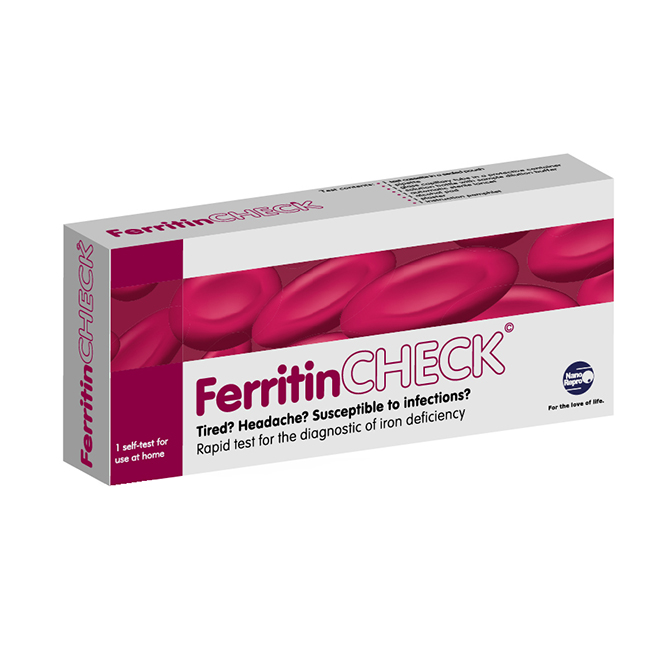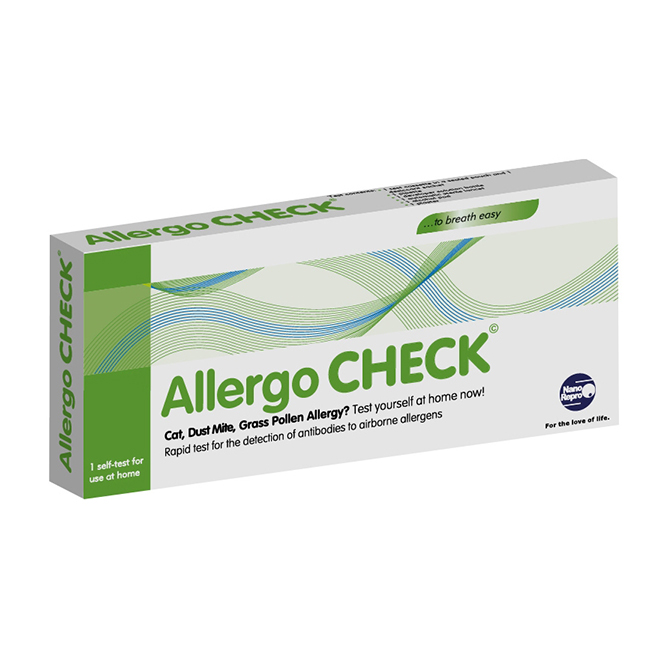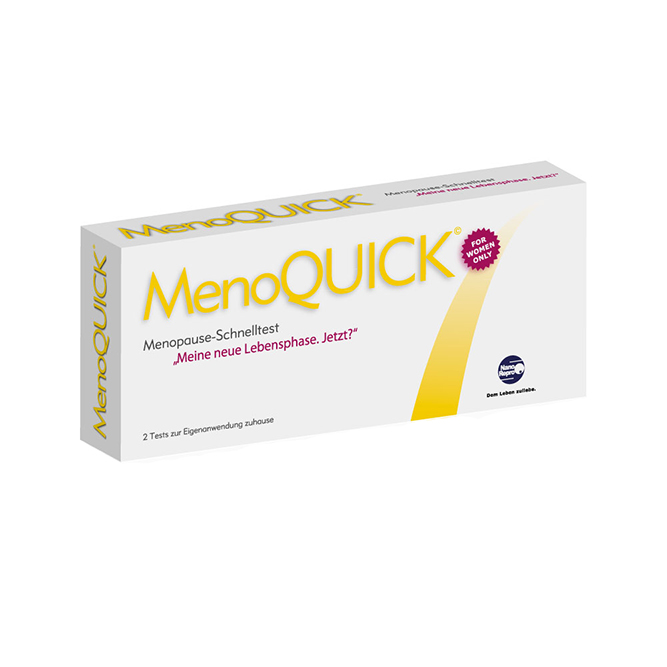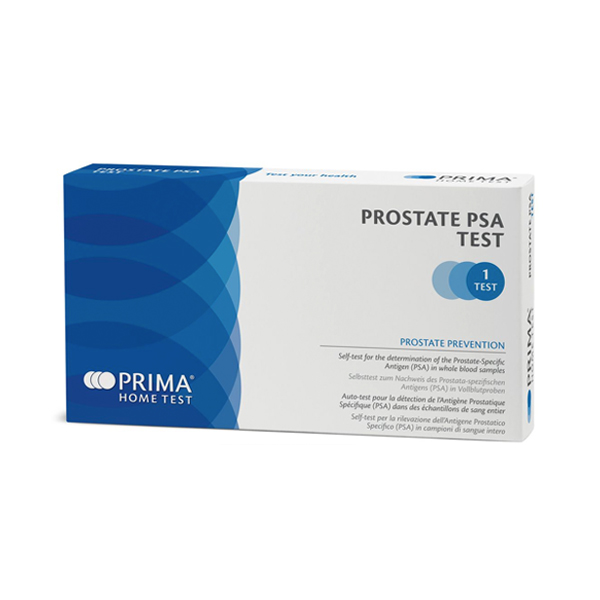GlutenCHECK
Gluten intolerance?
GlutenCHECK is a rapid test for use at home to detect the presence of IgA tissue transglutaminase antibodies (tTG) in whole blood. GlutenCHECK is suitable for an initial diagnosis of gluten intolerance as well as a therapy follow-up. a-tTG-IgA antibody levels should fall when gluten is removed from the diet. After 6 months on a gluten-free diet the antibodies will often become undetectable. The diagnosis must be confirmed by a healthcare professional along with further recommendations to maintain a gluten-free diet.
Each kit contains everything necessary for the test performance: a test cassette, an instruction leaflet, a solution bottle with sample dilution buffer, 1 automatic sterile lancet for comfortable blood sampling, a glass capillary tube, a pipette, an alcohol pad and a plaster. The results can be read within 10 minutes.
Background
Gluten intolerance (celiac disease), known as a sprue in adults, is an autoimmune disorder of the small intestine when the immune system attacks the body‘s own tissues. The common symptoms of gluten intolerance include bloating and diarrhoea, caused by a reaction to a gluten protein found in many foods. Weight loss, malnutrition and skin disorders could also be indications of gluten intolerance.

Advantage of self-test:
• Complete test kit with all the necessary accessories
• Safe & easy test procedure at home & immediate result
Who should get tested?
Additional Info:
- The test can only be performed if no previous change to a gluten-free diet has been conducted. As the levels of anti-tTG-IgA-antibodies drop gradually after gluten is removed from the diet, the test result could be compromised.
- Approximately 2-3% of celiac disease patients suffer from an overall IgA deficiency. For those patients, the test could result in a false – negative result.
- A negative result with the accompanying symptoms can indicate gluten sensitivity, which is treatable.
GlutenCHECK Instructions for use:
Heli-C-CHECK
Healthy stomach?
Heli-C-CHECK is a rapid test for use at home to detect the presence of Helicobacter pylori antibodies in whole blood. Heli-C-CHECK is intended as an aid in the diagnosis of Helicobacter pylori infection. The diagnosis must be confirmed and treated by a healthcare practitioner. Each kit contains everything necessary for the test performance: a test cassette, an instruction leaflet, a solution bottle with sample dilution buffer, 1 automatic sterile lancet for comfortable blood sampling, a glass capillary tube, a pipette, an alcohol pad and a plaster. The results can be read within 10 minutes.
Background
One of the most common causes of painful inflammation of the stomach lining is due to a bacterium called Helicobacter pylori. This leads to frequent abdominal discomfort and nausea. These bacteria colonise the stomach lining and release the enzyme Urease. The stomach tries to counteract this by increasing the production of gastric acid, disturbing the fragile PH equilibrium. Chronic inflammation in the stomach (gastritis) or ulcers may have further consequences. Helicobacter pylori bacteria can contribute to the development of diseases such as ulcers in the stomach and lymphoma progress (a type of cancer).

Advantages of self-test:
• Complete test kit with all the necessary accessories.
• Safe & easy test procedure at home with an immediate result.
• Gives information about a potential cause of symptoms before more invasive methods of examination are administered.
Who should get tested?
Adults suffering from painful inflammation of the stomach, acid reflux/heartburn, halitosis, nausea/vomiting.
Heli-C-CHECK Instructions for use:
TSH CHECK
Tired? Lethargic? Weight gain?
TSH CHECK is a rapid test for home use to detect hypothyroidism. TSH CHECK provides a simple, safe and accurate way to measure elevated levels of TSH in the blood. A value above 5 μIU / ml indicates hypothyroidism (normal value 0.4-4.5 μIU / ml). A positive test result is indicative of an increased TSH level and hypothyroidism can thus be assumed. The test uses a reliable cassette test procedure that will help you quickly determine if an elevated level of TSH in your blood is detectable.
Background
Elevated TSH values are an indicator of thyroid hypofunction. Thyroid hypofunction develops slowly, with increasing symptom strength and a progressing effect on a person’s health. Early stage detection is important to begin treatment in time. TSH reference levels in healthy adults are between 0.4 – and 4.5 µIU/mL, levels above 5 µIU/mL TSH are a strong indicator for hypothyroidism.

Advantages of self-test:
• Complete test-kit with all the necessary accessories.
• Safe & easy test procedure at home with immediate results.
• Narrows down the possible cause of symptoms, a doctor can use these results to detect the cause of hypothyroidism and initiate treatment.
Who should get tested?
Additional info:
• In persons of age (60+), TSH levels can increase naturally without the existence of symptoms.
• The test is not suited for children as their TSH levels can be elevated naturally.
TSHCHECK Instructions for use:
FOBCHECK
Healthy intestines?
FOBCHECK is a rapid one-step test for the qualitative detection of human haemoglobin in faecal samples. FOBCHECK is designed to help diagnose gastrointestinal disorders and detects human haemoglobin (Hb) with a cut-off level of 40 ng/ml. In addition to possible intestinal diseases such as diverticulitis, colitis, or colon polyps, the blood in the stool sample may indicate an early stage of colorectal cancer. The final diagnosis must be confirmed and treated by a healthcare practitioner.
Background
Hidden blood in the stool can be an indicator of various diseases such as diverticulitis, colitis, colon polyps or colorectal cancer. Screening for hidden blood can significantly reduce mortality from colorectal cancer. In the case of a positive test result, further investigation by a doctor is necessary for correct diagnosis and treatment.

Advantages of self-test:
• Rapid screening for early detection.
• Minimal sample contact.
• Easy to use.
• Detects human occult blood as low as 40 ng/ml haemoglobin as the threshold level.
• No cross-reactivity to haemoglobin from other species.
Who should get tested?
Adults suspecting colorectal cancer, polyps or patients with other gastrointestinal diseases or a family history of gastrointestinal diseases. Symptoms could be, among others, lower abdominal pain, frequent diarrhoea, changes in stool appearance (e.g. black stool) and weight loss.
Additional info:
Results are accurate and reliable:
- ○ Sensitivity of 97,1%
- ○ Specificity of 98,8%
- ○ Proven Accuracy of 98,6%
Each kit contains everything necessary for the test performance: a test cassette, an instruction leaflet, a sampling tube with developer solution and sample transfer device. The results can be read within 5 minutes.
FOBCHECK Instructions for use:
FerritinCHECK
Tired? Headache? Susceptible to infections?
FerritinCHECK is a rapid test for the diagnosis of iron deficiency at home. Iron deficiency is caused by an insufficient amount of iron in the body. This may be due to insufficient dietary intake, insufficient absorption of iron or iron loss from bleeding (menstrual bleeding, ulcers or other cases of abnormal bleeding). This is more prevalent during pregnancy or growth phase and has serious health consequences. FerritinCHECK is intended as an aid in the diagnosis of iron deficiency. The final diagnosis must be confirmed and treated by a healthcare practitioner.
Each kit contains everything necessary for the test performance: a test cassette, an instruction leaflet, a solution bottle with sample dilution buffer, 1 automatic sterile lancet for comfortable blood sampling, a glass capillary tube, a pipette, an alcohol pad and a plaster. The results can be read within 10 minutes.
Background
Iron deficiency prevalence is highest among young children and women of childbearing age. It is important that current body iron stores are sufficient. Iron is stored in a protein complex as Ferritin. Hence, Ferritin in the human blood serum is a laboratory marker of the total amount of iron stored in the body. Fatigue, headache, pallor, strong heartbeats or shortness of breath are all possible indications of an iron deficiency.
- Ferritin is a protein complex used for iron storage.
- Concentrations below 15 ng/ml indicate empty iron storage, while values up to 30 ng/ml are considered scarce.
- Causes can be, among others, growth, pregnancy, low iron uptake, blood loss or acute infections.

Advantages of self-test:
• Complete test kit with all the necessary accessories.
• Safe & easy test procedure at home & immediate result.
Who should get tested?
Athletes, children and women of child-bearing age suffering from headaches, fatigue, or shortness of breath under strain.
FerritinCHECK Instructions for use:
FertiQUICK
Knowing, not waiting.
FertiQUICK is a rapid test for use at home to detect the concentration of sperm in human semen with 95,1% accuracy.
The self-test shows whether the sperm count is considered within normal limits (at least 20 million sperm/ml). Other fertility factors are not detected by the test. The test uses a test cassette with an antigen-antibody (immunoassay) mode of action. The test results can be read through the appearance of a line in the test field. The package contains all the necessary items needed for the test: a test cassette in a sealed pouch, a solution bottle, a semen transfer syringe, a semen collection cup, a detailed instruction for use.
Background
“Infertility is not just a woman‘s concern. A problem with the male is the sole cause, or a contributing cause, of infertility in about 40% of infertile couples. About one fourth of infertile couples have more than one cause or factor related to their inability to conceive. About 10 to 15% of couples have no identifiable cause for their infertility after medical investigation” (Men´s Health, University Health Care).
Advantages of self-test:
- Complete test kit with all the necessary accessories.
- Safe & easy test procedure at home with immediate results.
- Comfortable and intimate atmosphere to run the test.
- Gives an idea of a possible cause of infertility.
Who should get tested?
Couples (specifically males) facing fertility problems.
| Analyte | Sample | Run time | Sensitivity | Specificity | Trueness | Accuracy | Cut-off level |
| ACRV1 / SP – 10 (Protein in the sperm head) | Human semen | 7 minutes | 97.00 % | 94.68 % | 95.88 % | 95.10 % | 20 Mio/mL |
Additional Info:
For a proper test procedure, complete liquefaction of the semen sample must occur. This refers to the changing of the semen sample from a thick gel to more of a liquid. In a healthy human male liquefaction should happen within 60 minutes at room temperature. As some men suffer from human semen hyperviscosity (HSH) with a drastically elongated liquefaction time, this can impair the test performance.
FertiQUICK Instructions for use:
AllergoCHECK
Cat, Dust Mite, Grass Pollen Allergy?
AllergoCHECK® is a rapid test for the detection of allergy antibodies to cat hair, grass pollen and house dust mites. With AllergoCHECK® you can quickly and easily determine if you have increased susceptibility to certain allergies. The test is designed to detect IgE antibodies in the blood.
Each kit contains everything necessary for the test performance: a test cassette, an instruction leaflet, a solution bottle with sample dilution buffer, 1 automatic sterile lancet for comfortable blood sampling, a glass capillary tube, a pipette, an alcohol pad and a plaster. The results can be read within 10 minutes
Background
Sneezing, runny nose or itchy eyes are not always the symptoms of a cold. Often it is an allergic reaction to something in the air. There are, among others, three common airborne allergens: cat hair, dust mites and grass pollen. Worldwide, airborne dust causes major problems for people with allergies.
In an allergy, the body‘s immune system reacts to essentially harmless substances from the environment (allergens) through a hypersensitivity reaction. Some of these allergens may be transmitted via the air. In the most common type of allergy (type I allergy), the immune system responds to allergen contact through the formation of immunoglobulin E (IgE) antibodies. If untreated, a persistent allergy to airborne pathogens can induce asthma.
Typical Signs of Allergy:
Who should get tested?
Children and adults suffering from frequent sneezing, runny nose, itchy eyes and ears, severe wheezing, coughing, shortness of breath or sinus problems.
Advantage of self-test:
Additional info:
|
Analyte |
Sample |
Run time |
Sensitivity |
Specificity |
Trueness |
Accuracy |
Cut-off level |
| Specific IgE antibodies against the allergens | Whole Blood | 10 minutes | 94% | 98% | 97% | 97% | 0.35 kU/L |
AllergoCHECK Instructions for use:
MenoQUICK
A new stage in life?
MenoQUICK is a qualitative test for home use to detect the status of menopause with 99,9% accuracy.
The test measures the concentration of the Follicle Stimulating Hormone (FSH) in the urine and indicates whether or not a woman has entered into menopause. This knowledge provides the possibility to discuss hormone treatment with a gynaecologist or doctor to evaluate the risk of osteoporosis.
Background
The typical “mature woman” is aged 40 years or older and has completed childbearing. During their late 40’s, most women enter the menopausal transition. This period of physiological change is due to ovarian senescence (the process of deterioration with age) and estrogen decline and is usually completed between ages 51 and 56. Menopause marks a defining point in this transition. Specifically, menopause is defined by the World Health Organization as the point in time of permanent menstruation cessation due to loss of ovarian function. Clinically, the menopause refers to a point in time that follows 1 year after menstruation cessation. The time leading up to menopause is called perimenopause. With ovarian senescence, declining hormone levels have specific effects on many tissues. Some effects lead to physical complaints such as vasomotor symptoms (night sweats, hot flashes, and flushes) and vaginal dryness, whereas others are metabolic and structural changes. These include osteopenia, osteoporosis, skin thinning, fatty replacement of the breast, cardiovascular changes and genitourinary atrophy. As a result, postmenopausal women have specific issues associated with ageing and estrogen loss that may negatively affect their individual health (Hoffman et. al., 2012).
MenoQUICK detects the level of FSH to indicate whether or not a woman has entered perimenopause (the time when the ovaries gradually begin to make less estrogen). If a woman knows that she has already entered perimenopause, she has the option to take the necessary steps to keep her body healthy and to avoid risks involved in menopause (e.g. osteoporosis, rising blood pressure, high cholesterol).
Who should get tested?
Mature women (around age 40) showing signs of menopause:
Advantage of self-test:
Additional info:
|
Analyte |
Sample |
Run time |
Sensitivity |
Specificity |
Trueness |
Accuracy |
Cut-off level |
|
Follicle Stimulating Hormone |
Urine |
5 minutes |
>99.9% |
>99.9% |
>99.9% |
>99.9% |
91.6 mlU/ml |
MenoQUICK Instructions for use:
PSA Test
Prostate Cancer Screening
Prostate-PSA Test checks potential prostatic dysfunctions controlling the PSA level in blood.
The Prostate-PSA Test checks the level of PSA (Prostate Specific Antigen) in blood, in order to screen for a possible prostate alteration. The test is intended for men aged over 45, who don’t have symptoms but wish to check their prostate; and also men with urinary tract symptoms like pain and increased frequency of urination. It is an immunochromatographic assay that, thanks to specific antibodies, is able to detect the level of PSA in the blood above 4 ng / ml, with special monoclonal gold-conjugate antibodies embedded to the strip. Results in just 5 minutes. This test is useful to perform a periodic prostate health status check, especially for men from 45 years of age, or in the presence of urinary tract symptoms, such as: difficulty, pain and increased frequency of urination. An early diagnosis is fundamental and could save lives.
What is PSA?
The Prostate Specific Antigen (PSA) is a protein produced by the epithelial cells of the prostate gland and it is part of the male genital tract. Located inside the pelvic cavity, under the bladder, is a pyramidal shape fibro-muscular structure, with a base at the top. Its function is to fluidify the ejaculation and therefore increase the sperm mobility. PSA also plays an important role in dissolving cervical mucus, allowing sperm to enter the uterus. Small quantities of PSA are normally found in the blood of men with a healthy prostate. Prostate pathologies (such as prostatitis, benign prostatic hyperplasia and cancer) lead to an increase in the blood levels of PSA. Its levels are also naturally elevated with age, after prostate surgery or specific diagnostic tests, for example: rectal examination, prostate biopsy, prostate ultrasound scan etc.
WHAT DOES IT CONTAIN?
– 2 sterile lancets for self-puncture and blood sampling
– 1 antiseptic cleaning gauze
– 1 dropper vial containing the diluent for the Test
– 1 plastic pipette for blood sampling
– 1 sealed aluminum bag containing:
– 1 Test device
– 1 desiccant sachet
How to use it:
– The sample is a blood drop taken with the sterile lancet contained in the box.
– Obtain a large drop of blood by massaging the finger and collect it with the plastic pipette.
– Put the drop of blood on the indicated point on the device.
– Add the diluent, wait for 5 minutes and read the result.
Who are the intended users?
Prostate PSA Test is intended for:
Why?
Checking the level of the PSA is useful to verify prostate health status. In the case of cancer, early detection and prevention can be life-saving.
What’s in the box?
1 x PSA Test – Prostate Cancer Screening Test





